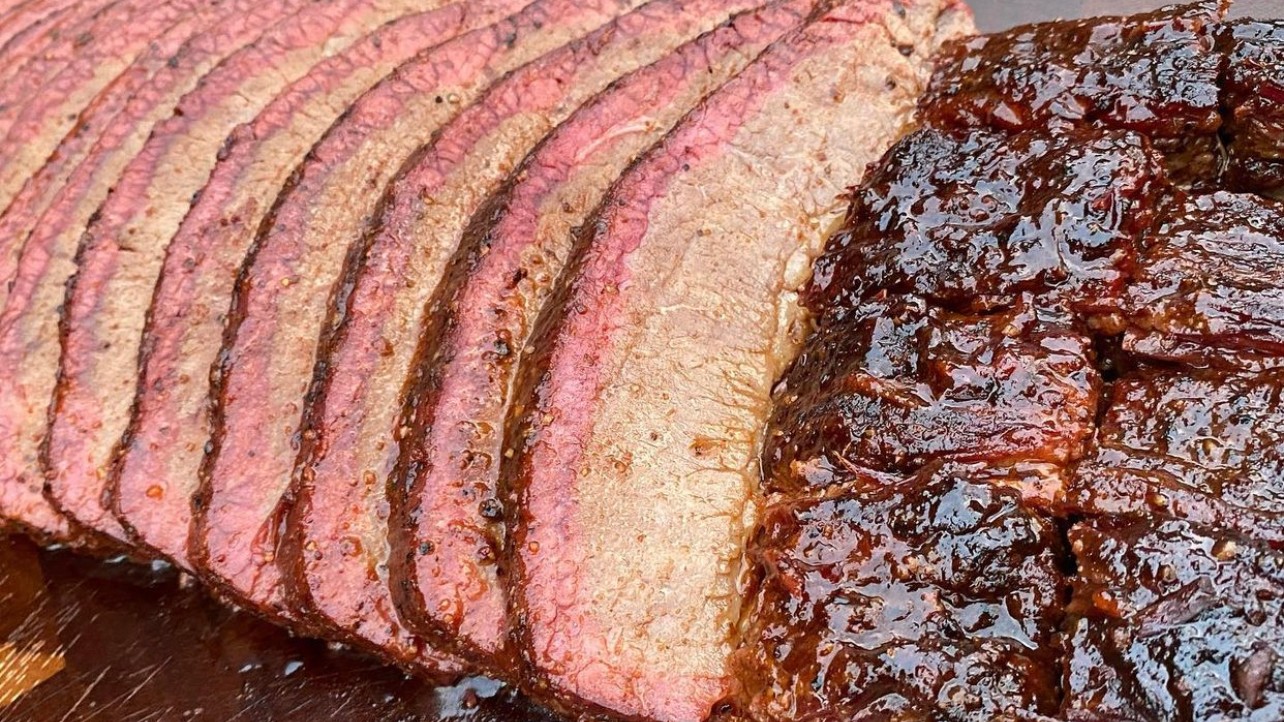Easy Smoked Brisket!
Rated 4.1 stars by 12 users
Category
Meat/Dinner
Cuisine
American
Author:
Will Collier
Brisket can be scary to cook for sure, it's a huge chunk of meat that can be extremely tough if you aren't careful. This recipe is extremely easy to follow and if you avoid the temptation of pulling the brisket off the smoker too early, your patience will be rewarded with tender, juicy brisket that your friends and family will talk about for months!

Ingredients
-
One 10-15 pound full packer brisket (flat and point still together, you can usually find these in the meat section at Sam's Club and Costco for a good price and a good quality)
-
DB180 Beef Brine Injection (Optional)
-
DB180 All Purpose
-
DB180 Steak & Beef
-
Wood Chunks or Pellets of choice (I prefer oak for long cooks on beef, if you can't find oak, hickory or pecan work great)
-
Pink Butcher Paper (preferred) or Heavy Duty Aluminum Foil (Secondary)
Directions
Choose the most marbled brisket you can find at the store. Look for the most thin white fat striations running through the grains of meat like tiger stripes, avoid briskets that are all red with no white and those that are stiff as a board when you pick them up. When picking a brisket up, the more flexible it is, the better.
Start by trimming off any of the thick outer fat around the point (the smaller, narrower end). Leave the fat cap on the flat (the wider, thinner end) alone.
Optional - Mix one scoop of DB180 Beef Brine with 16 ounces of beef stock. Inject the brisket in a grid pattern until the entire brisket has been injected. It's easiest to do this in a full size disposable aluminum pan.
Pat the brisket dry and season the entire brisket with a medium coat of DB180 All Purpose Seasoning. Follow that with a medium coat of DB180 Steak & Beef. Press the seasoning into the meat (DO NOT RUB!). Press it in firmly then leave the brisket at room temperature while you fire up the smoker.
Fire up the smoker to 250° until you have a clean, thin blue smoke with your wood flavor of choice. You do not want white bellowing smoke or heavy black smoke (pellet or electric smokers have no need to worry about this), let the coal and wood burn until you get a thin smoke you can barely see.
Place the brisket in the smoker fat cap down with the point (more narrow, marbled end) closest to the heat source. Shut the lid and maintain 250° for 6 hours, leave the brisket alone.
After 6 hours of smoke, pull the brisket out to wrap in either butcher paper or foil. Butcher paper will allow the brisket to retain the bark you've worked so hard for. If you cannot find pink butcher paper, heavy duty aluminum foil will work, but your bark will steam off. Wrap the brisket in butcher paper or a double layer of foil and put back on the smoker fat cap down for another 3 hours.
After 3 hours start probing the brisket flat (wider end) to check for doneness. Try not to focus on temperature alone, but if you're stuck on temperature, do not pull the brisket until the internal temperature is at least 203°. The better test is when the probe slides in and out like room temperature butter, it is ready. If there is any resistance or the brisket bounces back up at you when you probe it, leave it on for at least another hour before checking it again. A general rule of thumb with brisket is when you think it's done, leave it on for at least another 30 minutes. A brisket pulled off too soon is far worse than one that is left on too long.
Once the probe goes in and out like room temperature butter, pull the brisket and rest it for one hour. After an hour passes, take the brisket out and separate the point and flat. The point can be sliced into cubes, tossed in sauce, and put back on the smoker for another hour for burnt ends. Slice the flat against the grain, about the width of a number 2 pencil. If you feel the brisket is too tough, slice thinner, if it's too tender, slice it thicker!
Recipe Note
Brisket is the hardest BBQ meat to master, but if you don't overthink it and make sure you give it plenty of time, you will be happy with the results. Leaving it on longer is always better than pulling it too soon. The worst thing that can happen with a brisket that was left on too long is that it is so tender it falls apart and you end up chopping it for delicious sandwiches. That is a far more desirable outcome than pulling it too soon and ending up with a tough piece of meat that nobody can chew. Leave it on until that probe goes through it with ease! It's done when it's done, I've had briskets done in 8 hours and briskets done after 13 hours. I've had briskets done at 185° and briskets done at 210°. Keep in mind that the amount of cook time depends on the weight of the brisket, the smaller the brisket, the less time it will take. Best thing to do is learn the feel for when it is done and you will be a master of brisket in no time!!!

Customer Comments
Leave a Comment
What Our Customers Say